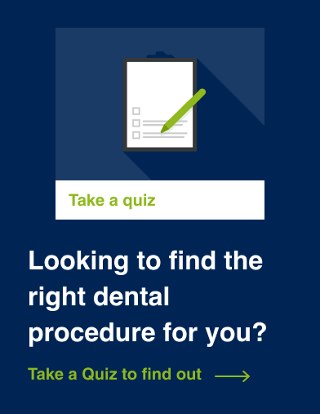Patient Articles
What is Gum Disease?
Gum disease, also referred to as periodontal disease, is an infection of the tissues that surround and support your teeth. It is a major cause of tooth loss and can occur when bacteria is not removed from under the gum line and then builds up over time. If the bacteria is not removed by typical at-home care such as brushing and flossing, it can begin to form plaque, a sticky and destructive substance that forms on our teeth. If left untreated, plaque turns into a harder substance called calculus, which can eat away at your gums and bone, causing loose, and ultimately lost teeth.
There are two levels of gum disease that can affect the gums: gingivitis and periodontitis. Gingivitis, characterised by red and irritated or bloody gums, is the milder form of gum disease. Without proper treatment it can lead to the more serious periodontitis, which is defined as inflammation and infection that destroys the tissues that support the teeth, including the gums, the periodontal ligaments, and the tooth sockets.
Both types of gum diseases are fairly common among adults in the United States and both generally can be reversed, or their symptoms lessened, with effective care consisting of professional cleaning at your dental office followed by daily brushing and flossing.
Symptoms and Causes of Gum Disease
Because gum disease is usually painless, you may not know you have it. Look for tell-tale symptoms if you think you might have a problem with the health of your gums. It’s also important to recognise that healthy gums are pale pink and firm. Symptoms of gum disease include:
- Bright red, purplish, or dusky red gums
- Red, swollen, or tender gums
- Receding gums, which can make teeth look longer than normal
- Bleeding gums
- New spaces developing between teeth
- Bad breath or a bad taste in the mouth
- Permanent teeth that are loose or separating
- A change in the way teeth fit together when biting
- Any change in the fit of partial dentures
There are a number of factors that can cause, increase the risk of, or worsen gum disease, including:
- Poor oral hygiene
- Smoking or chewing tobacco
- Genetics
- Crooked teeth that are hard to keep clean
- Medications, including steroids, certain types of anti-epilepsy drugs, cancer therapy drugs, some calcium channel blockers and oral contraceptives
How Do You Prevent Gum Disease?
When caught early, gum disease can usually be treated before tooth loss occurs. But, even better than catching it early, is to prevent it altogether. Good – and consistent – at-home oral care and regular dental checkups and cleanings can go a long way to help keep your gums healthy and disease-free. Follow these brushing and flossing tips to help you get started:
Brushing Tips
- Brush your teeth twice a day. It takes about two minutes to do a thorough job, so don’t rush through it. Don't brush immediately after eating, and don't forget to clean your tongue with a toothbrush or tongue scraper – tongues also collect bacteria.
- Use the proper equipment. Use fluoride toothpaste and a soft-bristled toothbrush that fits your mouth comfortably. Electric or battery-operated toothbrushes also help reduce plaque, sometimes even better than a manual brushing.
- Practice good technique. Hold your toothbrush at a slight angle and aim the bristles towards the area where your tooth meets your gum. Gently brush with circular short back-and-forth motions. Don’t press too hard – brushing too hard or with hard bristles can hurt your gums.
- Don’t forget the backs of your teeth. It’s easy to only focus on the fronts, so remember to brush the outside, inside, backs, and chewing surfaces of your teeth.
- Swish with mouthwash: Using a mouthwash containing fluoride can add another layer to your oral health regimen.
- Keep your equipment clean. Always rinse your toothbrush with water after brushing. Store your toothbrush in an upright position and allow it to air-dry until using it again. Consider switching between two brushes and allowing one to dry before using it again.
- Know when to replace your toothbrush. Invest in a new toothbrush or a replacement head for your electric or battery-operated toothbrush every three months — or sooner if the bristles become irregular.
Flossing Tips
- Don't skimp. Cut off about 18 inches of dental floss and wind most of it around the middle finger on one hand, and the rest around the middle finger on the other hand.
- Be gentle. Grip the floss tightly between your thumbs and forefingers, but don’t floss too hard. Guide the floss between your teeth using a gently rubbing motion. When the floss reaches your gum line, curve it against one tooth, making a ‘C’ shape. Don't “saw” the floss or snap it roughly into your gums.
- Floss one tooth at a time. Use the floss to gently rub the side of each tooth in an up-and-down motion. Unwind fresh floss as you progress to the rest of your teeth.
- Keep up the good work. If you find it hard to handle floss, use an alternative cleaning method such as a dental pick, pre-threaded flosser, a tiny brush that reaches between teeth, a water flosser, or wooden or silicone wedge plaque remover.
Keep in mind that it doesn't matter if you brush or floss first, as long as you do a thorough job – you can't always reach bacteria in tight spaces between your teeth and under the gum line with a toothbrush. In addition to daily brushing and flossing, consider resisting the temptation to use toothpicks or other objects that could injure your gums and let in bacteria. If you smoke, try to quit. Using tobacco increases your risk of gum disease and tooth loss. Other risk factors for gum disease include age, smoking, diet, and genetics. If you are at increased risk, be sure to talk with your dental professional.
Remember, you don’t have to lose teeth to gum disease. See your dentist if you suspect you have gum disease – the sooner you treat it the better.
Looking to find the right
dental procedure
for you?
Take a Quiz to find out 

Take a quiz


